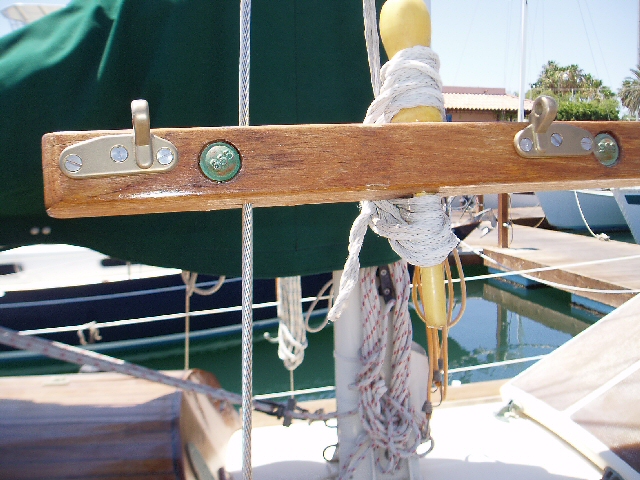We do not normally put projects in this set of
WEB pages, but we thought it would best fit here, at the same time we did our 2-year
gear report.
It became evident during our first summer in the Sea of Cortez that we were
lacking enough passive power generation to keep up with the demands.
During the intensive heat in the Sea, with the air temp over 100-degree F and humidity over 80%,
and constant water temperature over 95 degrees F extensive demands were made on our
systems. When the engine room temperature rose so high, even with the doors off
that the alternator would shut down; we knew we needed to make additions.
Our goal was to add solar panels to bring our generation during the height of
the day up to or above 20 amps. With that in mind, we went about searching for
a set of panels that could generate the power and still fit aboard our 27-foot
boat.
What we have come up with is a set of panels that can be set
up when required and be safely stored below when not needed.
NOTE: All Watts and Amps stated here are per the
manufactures specifications.
We will keep our 4 UniSolar flexible panels and use them as
we have in the past. They put out 32 Watts or 1.94 Amps each for a total of 128
Watts or 7.76 Amps.
We placed on order, and have received 9 new solar panels. We delt with Alter Systems (www.altersystems.com) , 1-866-568-5579.
We will permanently mount one panel, a Kyocera KC-85, on our aft
rail. It will fit between our split backstay and our Monitor wind vane. This is
in the clear sun almost all of the time and can work even if we are sailing.
Granted, a following wave COULD take it out, but we will live with that. It
puts out 85 Watts or 5.02 Amps of power.
The remainder of the 8 panels will be mounted in pairs, 2 to
a set (panel assembly). This will provide 4 panel assemblies. Each assembly
will fold in the center so that the actual solar panels will be protected on
the inside when in the folded position. With the panels in the folded position
I believe we can still sail in calm weather.
Each of the 8 solar panels, Duralite model GPDL-20, provides 20 Watts or 1.2 Amps of
power. Each assemble will provide 40 Watts or 2.4 Amps. Therefore the 4
assemblies can provide a total of 160 Watts or 9.6 Amps.
Our total solar generation capability will be approximately
373 Watts or 22.38 Amps.
During the recent summer we were able to obtain 4 lower
power Amorphous Silicon solar panels to use as a “proof of concept” test. In the
following photos you will see these panels, not the final setup.
First, understand our normal cruising style. We tend to get
to an anchorage, and if we like it, we may stay for a week or more. So it is
not a problem to anchor, then set up panels, fold them over night and then re-set them again in the morning.
We contemplated mounting larger panels on the bow pulpit,
but saw this as a major problem. Without putting ridged railings on instead of
lifelines, they would not mount on the side. I might add, we found ridged rails
to be visually objectionable on a Nor’Sea.
The one place we do have to mount a panel is on the
outboard side of our pin-rails. We have had pin-rails on Guenevere since we
have owned her. They are wonderful in keeping our halyards quiet during a blow,
and generally keeping our lines in order.
We used snap hinges. These hinges allow us to securely hinge
and item to the pin-rails and still enable us to remove it as needed to store
it below when the weather pips up or for extended storage when at a marina that
has dock power available.

This photo shows half of the snap hinge in place on
the pin-rail.

A closer view.

This is a close up of the panel mounted to the hinge half, In the down
position, or reefed for the night. A Bungee around the stay keeps it
secure even in moderate winds.

This shows two panels in the stowed position.

Here is a photo of two panels in the up position and ready to be
connected to provide power. In this system, I used small lines with
small shackels from a ring on the upper stay (that also holds our boat
hook). In the final version I will be looking for a way to support them
from below.

Here is a closer view of the panel hinge with the panel in the up position
There you have it. This is how we will power our systems with 13 solar panels and without running the engine so often.






